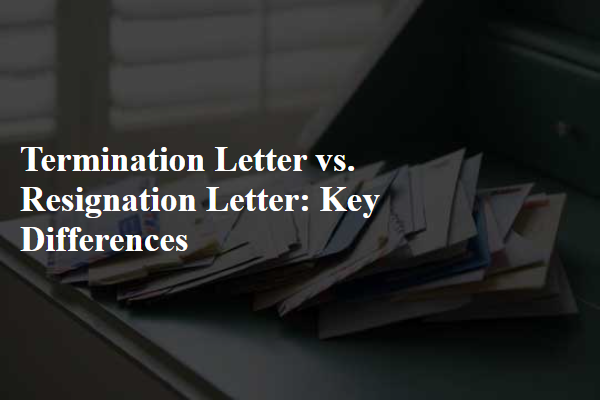
A termination letter must clearly state the reason for employment termination, the effective date, and any severance or final paycheck details. It should also outline the return of company property and the status of benefits or unemployment eligibility. Including contact information for follow-up questions ensures clarity and minimizes misunderstandings.
Employee Information
What are the key elements every termination letter should include? A clear statement of the employment termination is essential to avoid misunderstandings. Including the effective date of termination and reason for the decision ensures transparency and legal compliance.
Why is it important to mention the employee's final paycheck details? Providing information about final pay, including accrued benefits and last working day, helps clarify financial obligations. This detail protects both employer and employee rights and prevents disputes.
What role does information about return of company property play in a termination letter? Specifying the requirements for returning items like badges, keys, and equipment maintains company security. Clear instructions help facilitate a smooth transition and reduce potential losses.
How can mentioning continuation of benefits assist the terminated employee? Outlining details about healthcare, COBRA continuation, or severance packages offers support during the post-employment period. This inclusion reflects professionalism and can lessen employee anxiety.
Why should contact information be included in a termination letter? Providing a point of contact for questions or concerns promotes open communication and resolution of outstanding issues. This element ensures the employee knows where to seek assistance if needed.
Termination Date
Every termination letter must clearly communicate the end of employment while maintaining professionalism and legal compliance. Key elements ensure the message is precise and reduces potential disputes.
- Clear Termination Date - Specifies the exact last day of employment for clarity and record-keeping.
- Reason for Termination - Provides a concise explanation to justify the dismissal and prevent misunderstandings.
- Information on Final Pay and Benefits - Details the compensation owed, including severance, unused vacation, and benefits continuation.
Statement of Termination
Termination letters must clearly communicate the end of employment to ensure legal clarity and employee understanding. Including essential elements helps protect both the employer and employee from potential disputes.
- Reason for Termination - Specifies the cause or circumstance leading to the employment ending.
- Effective Date - States the exact date when the termination becomes official.
- Final Pay Details - Outlines compensation, including last salary, benefits, and accrued leave.
Reason for Termination
A termination letter must clearly state the reason for the employee's dismissal. It provides a formal record that helps both parties understand the decision.
Key elements include the employee's name, the termination date, and a concise explanation for the termination. The letter should also outline any final paycheck details, including unused vacation or benefits. Including information about return of company property and contact information for further questions ensures clarity and professionalism.
Reference to Prior Warnings
Termination letters serve as formal documents that clearly communicate the end of an employment relationship. Including key elements ensures legal compliance and helps avoid misunderstandings.
- Employee Information - Clearly state the employee's full name and position to avoid any ambiguity.
- Termination Date - Specify the exact date the termination takes effect for record-keeping and clarity.
- Reason for Termination - Provide a concise and factual explanation to support transparency and legal protection.
Including these essential elements creates a clear, professional, and legally sound termination letter.
Final Pay and Benefits Details
A termination letter must clearly state the employee's name, position, and the effective date of termination to ensure there is no confusion about the end of employment. It should include the specific reason for termination, whether it is performance-related, redundancy, or misconduct, to provide transparency and legal protection. Finally, the letter must outline any final pay details, benefits continuation, and return of company property instructions to facilitate a smooth and compliant separation process.
Return of Company Property
| Key Element | Description |
|---|---|
| Employee Information | Full name, job title, and department of the employee being terminated for clear identification. |
| Date of Termination | Specifies the exact last working day to avoid any confusion about the termination timeline. |
| Reason for Termination | A concise, factual explanation for the termination, respecting legal and company policy requirements. |
| Notice Period | Details about any notice given or payment in lieu of notice, outlining the end of employment expectations. |
| Final Pay and Benefits | Information on the final paycheck, unused vacation payout, severance packages, and benefits continuation. |
| Return of Company Property | Instructions on returning company assets such as keys, laptops, and ID badges before the termination date. |
| Confidentiality and Non-Disclosure | Reminders regarding confidentiality agreements and obligations post-termination. |
| Contact Information | Details of whom to contact for questions related to termination or final settlements. |
| Signature Lines | Space for signatures of the employee and employer to acknowledge and confirm receipt of the letter. |
Next Steps and Exit Process
Termination letters must clearly state the employee's name and the effective date of termination. Including the reason for termination helps avoid misunderstandings and provides legal protection.
Details regarding final paycheck, benefits, and any severance package should be specified. Information about returning company property and rights to appeal or contact HR is essential.
Contact for Questions
Termination letters must clearly state the employee's full name and the effective date of termination to avoid any confusion. Including the specific reason for termination ensures transparency and legal clarity.
It is essential to outline any severance pay, benefits, or final paycheck details to inform the employee of their entitlements. A termination letter should also provide instructions for returning company property and contact information for further questions.
Signature and Date
A termination letter must clearly state the employee's name, job title, and the effective date of termination to avoid any confusion. It should include specific reasons for termination, whether due to performance issues, misconduct, or company restructuring, ensuring transparency and legal compliance. The letter must also outline any final pay details, severance information, and return of company property instructions to provide clear next steps for the employee.



Comments